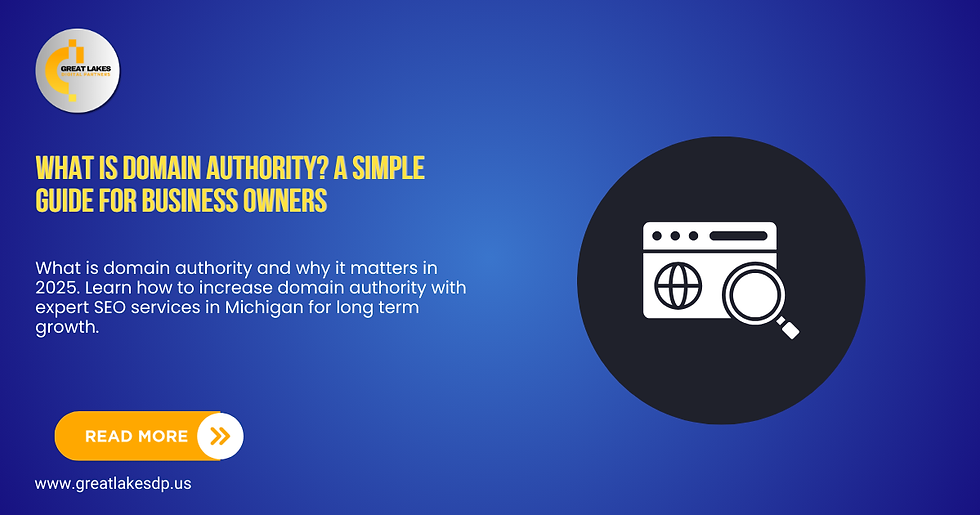On-Page SEO Checklist: How to Optimize Every Page Like a Pro
- Great Lakes
- Jul 9
- 3 min read

If you want to win on Google in 2025, your website needs more than great design — it needs strategic On-Page SEO. As search engine algorithms become smarter, businesses must ensure every page is fully optimized to satisfy both users and crawlers.
This guide walks you through every step of On-Page SEO, offering expert-level strategies that are easy to implement. Let’s get your pages ranked where they deserve to be — at the top.
Your 2025 On-Page SEO Checklist
1. Start with Intent-Based Keywords
Keyword research is still king. Use tools like Google Search Console, Ahrefs, or Ubersuggest to find high-volume, low-competition keywords that match what your users are searching. Focus your page around one main keyword — in this case, On-Page SEO — and incorporate relevant long-tail variations.
Stat: Pages targeting long-tail keywords get 2.5x more qualified traffic (Backlinko, 2025).
2. Optimize Meta Tags Strategically
Your page title and meta description are what users see first.
Include the On-Page SEO keyword in both
Keep your title under 60 characters
Limit your meta description to 155–165 characters
Add power words to drive clicks
Also, incorporate secondary keywords like SEO Optimization or SEO for Google for broader visibility.
3. Craft Clean URLs and Header Tags
URLs should be short, descriptive, and include your main keyword.
Use H1 for your page title (include the keyword once), followed by H2s and H3s to structure your content. This improves readability and helps Google understand the hierarchy.
4. Write Quality, Helpful Content
Google’s Helpful Content Update is clear — write for people first. Use short paragraphs, bullets, and visuals. Answer real user questions. Your content should be:
Unique
Relevant to user intent
Easy to scan on mobile
Adding secondary keywords like SEO Services in Michigan or SEO Agency in Michigan helps with geo-targeting if you’re focused on local SEO.
5. Image Optimization
Every image should:
Be compressed for fast loading
Include descriptive filenames
Use keyword-rich alt text without keyword stuffing
This supports accessibility and gives Google more content to index.
6. Internal and External Linking
Link to:
Other pages on your website to distribute authority
Trusted external sources to back up data or claims
Avoid broken links and check your anchor text is relevant and varied.
Stat: Pages with 2–3 internal links perform 40% better in Google rankings (Moz, 2025).
7. Speed, Mobile & User Experience
With mobile-first indexing in place, ensure your site:
Loads in under 3 seconds
Is fully responsive
Meets Google’s Core Web Vitals
Use Google PageSpeed Insights or Lighthouse to evaluate performance.
8. Use Schema Markup
Add structured data to:
Enhance rich snippets
Improve click-through rates
Help Google understand your page better
Popular types: FAQ schema, product schema, article schema.
What Is On-Page SEO?
On-Page SEO refers to all the actions you can take directly within your webpage to improve its visibility on search engines. This includes content, titles, headers, image alt text, URL structure, and more.
Ready to Dominate with Great On-Page SEO?
Whether you're updating an old blog or publishing a new service page, mastering On-Page SEO is non-negotiable in 2025. At Great Lakes, we offer tailored SEO solutions that align with the latest search trends and user behavior. As a trusted SEO Agency in Michigan, we don’t just optimize your site — we help it grow.
5 Unique FAQs About On-Page SEO
1. Is On-Page SEO only about keywords?
No, while keywords are essential, On-Page SEO includes many other elements like user experience, internal linking, image optimization, and mobile readiness. It's a holistic approach to improving a page's performance on search engines.
2. Can I rank without backlinks if my On-Page SEO is perfect?
In low-competition niches, yes. Great On-Page SEO can help you rank without many backlinks. But in competitive markets, backlinks amplify your efforts.
3. How often should On-Page SEO be updated?
You should review and refresh content at least every 3 to 6 months. Update outdated info, check for broken links, and improve keyword relevance to stay current.
4. Does Google prioritize mobile On-Page SEO differently?
Yes, with mobile-first indexing, Google ranks your mobile content first. This means mobile responsiveness, load speed, and mobile UX are all critical for rankings.
5. Is schema markup necessary for all pages?
Not always, but using schema on blogs, FAQs, and service pages can help you earn rich results, increase click-through rates, and enhance your SEO Optimization strategy.











Comments